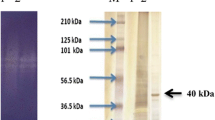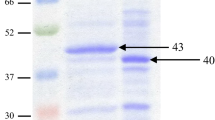Abstract
In order to select bacterial strains effectively secreting mannanase activity for the production of prebiotic mannooligosaccharides, a two-step screening procedure was performed. Enriched cultures from isolation medium containing copra meal were primary screened on an isolation agar medium containing 1% locust bean gum (LBG), which resulted in 48 mannanase-producing bacterial isolates with significant clearing zones on the mannan-containing agar. However, only nine isolates showed appreciable mannanase activities against copra meal in their culture supernatants (0.054–0.185 U/mg of protein) as determined in a standard assay based on the detection of reducing sugars released from this substrate. The isolates CW2-3 and ST1-1 displayed the highest activity against LBG and copra meal, respectively. Copra mannan hydrolysates that were obtained by using crude mannanase from these nine isolates were further used for a secondary screening towards a growth-enhancing activity on Lactobacillus reuteri and inhibitory activity against Escherichia coli as well as Salmonella Enteritidis, resulting in 0.09–2.15 log CFU/ml enhancing activity and low inhibitory activity of 0.46–1.78 log CFU/ml as well as 0.37–1.72 log CFU/ml, respectively. The hydrolysate of CW2-3 mannanase showed the highest enhancing activity of 2.15 log CFU/ml while isolate ST1-1 was most effective with respect to growth inhibition against E. coli E010 and S. Enteritidis S003 with 0.76 and 1.61 log CFU/ml, respectively. Based on morphological, physical, biochemical and genetics properties, isolates CW2-3 and ST1-1 were identified as Klebsiella oxytoca and Acinetobacter sp., respectively. Crude mannanase activity from these two strains was characterized preliminarily. The pH optima of mannanase activity from Klebsiella oxytoca CW2-3 and Acinetobacter sp. ST1-1 were 7 and 6, respectively. The enzymes were stable at 4°C over a pH range of 3–6 and 3–10, respectively.



Similar content being viewed by others
References
Abe J, Hossain ZM, Hizukuri S (1994) Isolation of β-mannanase producing microorganisms. J Ferment Bioeng 3:259–261
Alemu M, Laemkom P, Doi K, Ohmomo S, Yajima M, Nitisinprasert S (2006) Characterization of bacteriocin-producing lactic acid bacterium strain N1-33 isolated from edible fermented bamboo shoot. Kasetsart J (Nat Sci) 40:486–498
Araujo A, Ward OP (1990a) Hemicellulases of Bacillus species: preliminary comparative studies on production and properties of mannanases and galactanases. J Appl Bacteriol 68:253–261
Araujo A, Ward OP (1990b) Mannanase component from Bacillus pumilus. Appl Environ Microbiol 56:1954–1956
Akino T, Nakamura N, Horikoshi K (1988) Characterization of three β-mannanases from an alkalophilic Bacillus sp. Agric Biol Chem 52:773–779
Brown AE (2005) Benson’s microbiological application: laboratory manual in general microbiology, 9th edn. McGraw Hill, Boston
Burhanudin S, Dingle J (2006) Proc. Queensland Poult. Sci Symp Australia. Avaliable via DIALOG. http://www.idp.com. Cited 1 Feb 2006
Carr EL, Kampfer P, Patel BKC, Gurtler V, Seviour RJ (2003) Seven novel species of Acinetobacter isolated from activated sludge. Int J Syst Evol Microbiol 53:953–963
Center for Agricultural Information (2005) Agricultural statistics of Thailand crop year bulletin no. 414. Office of Agricultural Economics, Bangkok, Thailand
Di Cello F, Pepi M, Baldi F, Fani R (1997) Molecular characterization of an n-alkane-degrading bacterial community and identification of a new species, Acinetobacter venetianus. Res Microbiol 148:237–249
Ethier N, Talbot G, Sygusch J (1998). Gene cloning, DNA sequencing, and expression of thermostable β-mannanase from Bacillus stearothermophilus. Appl Environ Microbiol 64:4428–4432
Gibson GR, Ottaway PB, Rastall RA (2000) Prebiotics: new developments in functional foods. Chandos Publishing, Oxford, UK
Golias H, Dumsday GJ, Stanley GA, Pamment NB (2002) Evaluation of a recombinant Klebsiella oxytoca strain for ethanol production from cellulose by simultaneous saccharification and fermentation: comparison with native cellobiose-utilising yeast strains and performance in co-culture with thermotolerant yeast and Zymomonas mobilis. J Biotechnol 96:155–168
Hossain MZ, Abe J, Hizukuri S (1996) Multiple forms of β-mannanase from Bacillus sp. KK01. Enzyme Microb Technol 18:95–98
Ishihara N, Chu DC, Akachi S, Juneja LR (2000) Preventive effect of partially hydrolyzed guar gum on infection of Salmonella enterica in young and laying hens. Poult Sci 79:689–697
Jiang Z, Wei Y, Li D, Li L, Chai P, Kusakabe I (2006) High-level production, purification and characterization of a thermostable β-mannanases from the newly isolated Bacillus subtilis WY34. Carbohydr Polym 66:88–96
Lowry OH, Rosebrough NH, Farr AL, Randall R (1951) Protein measurement with the Folin phenol reagent. J Biol Chem 193:265–275
McCleary BV (1988) β-Mannanase. Meth Enzymol 160:596–610
Mendoza NS, Arai M, Kawaguchi T, Yoshida T, Joson LM (1994) Purification and properties of mannanase from Bacillus subtilis. World J Microbiol Biotechnol 10:551–555
Miller GL (1959) Use of dinitrosalicylic acid reagent for determination of reducing sugar. Anal Chem 31:426–428
Mitterdorfer G, Kneifel W, Viernstein H (2001) Utilization of prebiotic carbohydrates by yeasts of therapeutic relevance. Lett Appl Microbiol 33:251–255
Mohammad ZH, Abe J, Hizukuri S (1996) Multiple forms of β-mannanase from Bacillus sp. KK01. Enzyme Microb Technol 18:95–98
Moniruzzaman M, Lai X, York SW, Ingram LO (1997) Isolation and molecular characterization of high-performance cellobiose-fermenting spontaneous mutants of ethanologenic Escherichia coli K011 containing the Klebsiella oxytoca CasAB operon. Appl Environ Microbiol 63:4633–4637
Naughton PJ, Mikkelsen LL, Jensen BB (2001) Effects of nondigestible oligosaccharides on Salmonella enterica Serovar Typhimurium and nonpathogenic Escherichia coli in the pig small intestine in vitro. Appl Environ Microbiol 67:3391–3395
Nishimura Y, Ino T, Lizuka H (1988) Acinetobacter radioresistens sp. nov. isolated from cotton and soil. Int J Syst Bacteriol 38:209–211
Noel RK et al (eds) (1984) Bergey’s manual of systematic bacteriology. William &Wilkins, Baltimore
Nitisinprasert S, Nilphai V, Bunyun P, Sukyai P, Doi K, Sonomoto K (2000) Screening and identification of effective thermotolerant lactic acid bacteria producing antimicrobial activity against Escherichia coli and Salmonella sp. resistant to antibiotics. Kasetsart J (Nat Sci) 34:387–400
Oda Y, Komaki T, Tonomura K (1993a) Purification and properties of extracellular β-mannanases produced by Enterococcus casseliflavus FL2121 isolated from decayed konjac. J Ferment Bioeng 76:14–18
Oda Y, Komaki T, Tonomura K (1993b) Production of β-mannanase and β-mannosidase by Enterococcus casseliflavus FL 2121 isolated from decayed konjac. Food Microbiol 10:353–358
Oyofo B, deLoach JR, Corrier DE, Norman JO, Ziprin RL, Mollenhauer HH (1989) Prevention of Salmonella typhimurium colonization of broilers with D-mannose. Poult Sci 68:1357–1360
Puchart V, Vrsanska M, Svoboda P, Pohl J, Ogel ZB, Biely P (2004) Purification and characterization of two forms of endo-β-1,4-mannanases from a thermotolerant fungus, Aspergillus fumigatus IMI 385708 (formerly Thermomyces lanuginosus IMI 158749). Biochem Biophys Acta 1674:239–250
Qian Y, Yomano LP, Preston JF, Aldrich HC, Ingram LO (2003) Cloning, characterization, and functional expression of the Klebsiella oxytoca xylodextrin utilization operon (xyn TB) in Escherichia coli. Appl Environ Microbiol 69:5957–5967
Rättö M, Poutanen K (1988) Production of mannan-degrading enzymes. Biotechnol Lett 10:661–664
Rodriguez LR, Tait RC (1983) Recombinant DNA techniques: an introduction. Benjamin/Cummings Publishing, Menlo Park
Sachslehner A, Haltrich D (1999) Purification and some properties of a thermostable acidic endo-β-1,4-D-mannanase from Sclerotium (Athelia) rolfsii. FEMS Microbiol Lett 177:47–55
Spring P, Wenk C, Dawson KA, Newman KE (2000) The effect of dietary mannooligosaccharides on Ceca of Salmonella challenged broiler chicks. Poult Sci 78:205–211
Takahashi R, Kusakabe I, Kobayashi H, Murakami K, Maekawa A, Suzaki T (1984) Purification and some properties of mannanase from Streptomyces sp. Agric Biol Chem 48:2189–2195
Tamuru Y, Araki T, Amagoi H, Mori H, Morishita T (1995) Purification and characterization of an extracellular β-1,4-mannanase from a marine bacterium, Vibrio sp. strain MA-138. Appl Environ Microbiol 61:4454–4458
Wiedmann-Al-Ahmad M, Tichy HV, Schon G (1994) Characterization of Acinetobacter type strains and isolates obtained from wastewater treatment plants by PCR fingerprinting. Appl Environ Microbiol 60:4066–4071
Zakaria MM, Yamamoto S, Yagi T (1998) Purification and characterization of an endo-1,4-β-mannanase from Bacillus subtilis KU-1. FEMS Microbiol Lett 158:25–31
Zhang J, He ZM, Hu K (2000) Purification and characterization of β-mannanase from Bacillus licheniformis for industrial use. Biotechnol Lett 22:1375–1378
Zhou S, Ingram LO (1999) Engineering endoglucanase-secreting strains of ethanologenic Klebsiella oxytoca P2. J Ind Microbiol Biotechnol 22:600–607
Acknowledgements
This work was supported by the Commission on Higher Education, the Ministry of Education, Royal Thai Government, and the ASEAN-EU University Network Programme (AUNP).
Author information
Authors and Affiliations
Corresponding author
Rights and permissions
About this article
Cite this article
Titapoka, S., Keawsompong, S., Haltrich, D. et al. Selection and characterization of mannanase-producing bacteria useful for the formation of prebiotic manno-oligosaccharides from copra meal. World J Microbiol Biotechnol 24, 1425–1433 (2008). https://doi.org/10.1007/s11274-007-9627-9
Received:
Accepted:
Published:
Issue Date:
DOI: https://doi.org/10.1007/s11274-007-9627-9




